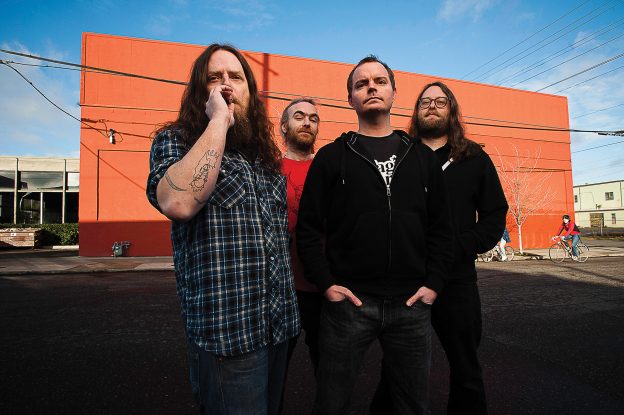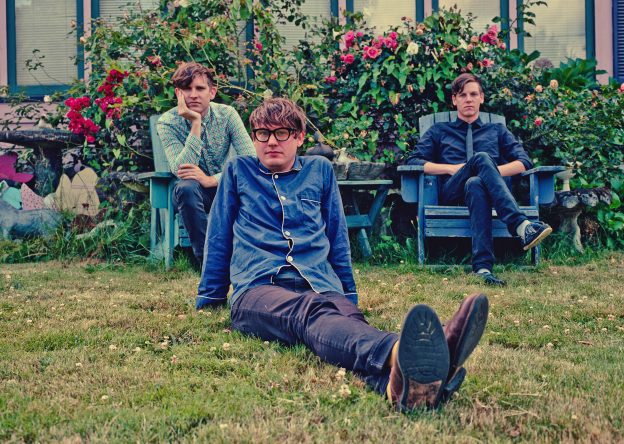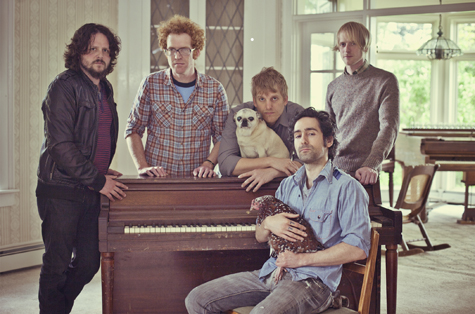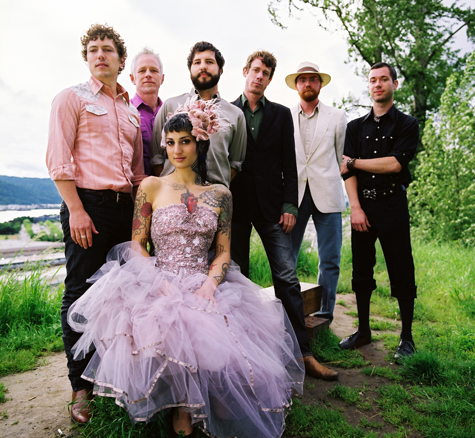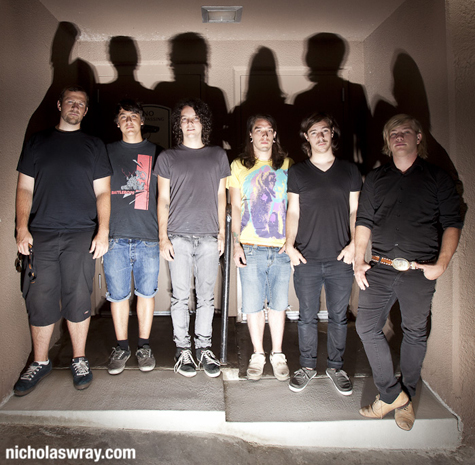It’s a 10-hour drive from Sacramento to Portland, Ore., though not a difficult one: take a right on I-5 and go straight for a while. Buy some olive oil in Corning, chuckle for a few minutes as you pass Weed, keep her steady over Grant’s Pass. Avoid Salem. You’re there.
For Portland’s BRAINSTORM, the former duo-now-trio of drummer Adam Baz, guitarist Patrick Phillips and bassist Dasha Shleyeva, who recently joined the group for a national tour, the distance between each city has proved inconsequential to the troupe’s appreciating of Sacramento music. Baz tells me that they’ve already circled their Sacramento show at Bows and Arrows on Nov. 3, highlighting the affair as a small reunion of sorts.
“For whatever reason we have kind of a sister community in Sacramento,” says Baz, calling from New York City before a week of CMJ’ing. “Part of it, for a while, was there were a lot of really talented Sacramento-based musicians living in Portland, and we got to know a lot of them. We hit it off.” Heat Waves, BRAINSTORM’s second album released earlier this month, was produced by Sacramentan Robby Moncrieff in Portland’s Type Foundry Studios. Baz recalls booking a show with Moncrieff and Zach Hill’s project What’s Up? a few years back, and Moncrieff’s production work on such albums as Dirty Projectors’ Bitte Orca and with locals Ganglians and Appetite grabbing the group’s attention early on.
“We’ve always respected his production, and his ear,” Baz says of Moncrieff. “I think he’s really good at recording pop albums in a way that yields a much more interesting product than some typical pop recording” (think Appetite’s Scattered Smothered Covered and Ganglians’ Still Living).
And if we’re categorizing BRAINSTORM’s brand of pop, we’d at the very least call it atypical. The band’s 2009 release, Battling Giants, blends riff-y, Math rock tempos stopping on a dime into squeaky clean, glee club-ish vocals over a tuba. The album should receive praise for its bold musicality–and it did–but Baz admits such a repertoire “can at times make it challenging for a listener.”
“Part of the challenge of the band is trying to sync together these different genres in a way that still is coherent and not too all over the place,” he says. “Some of our older material in particular is a little more scattered.”
Heat Waves can be seen as an extension of the BRAINSTORM’s debut in terms of incorporating a variety of influences, though the sophomore effort distills these influences with greater care, and, perhaps, works them in more seamlessly. “Flat Earth,” the album’s opener, is at its core a ‘60s homage: a reserved guitar melody over drums more concerned with keeping time than setting new polyrhythm, and lyrics looking back on a love gone bad. We then transition into an upbeat movement, more vocal harmonies with Phillips’ guitar returning to the forefront–and then back again to the song’s original thrust. If this sounds like hard work, I assure you it’s not. Transitions in and out of BRAINSTORM’s temperamental shifts are clear, no-stress progressions.
“Forms Without a Frame” could be the album’s flag bearer for the new clarity in approach–a guitar-centric pleaser, Baz’s more understated efficiency on drums driving beneath, and a tuba in the back heartily bridging each chorus. BRAINSTORM has succeeded in staying true to its eclectic roots while aging into something more refined.
From a songwriting perspective, however, BRAINSTORM has changed little since its inception: “It’s a pretty democratic, organic process. Patrick and I usually bring little sections of songs to the table. I’ll have an idea for a riff or a vocal part, or just a drum pattern, and kind of jam on that and see where it takes us.” Piecing often disparate elements together continues to be a challenge, though Heat Waves tones down the experimentation of BRAINSTORM’s debut, or at least that was a goal Baz and Phillips set out for themselves.
“I hope [Heat Waves] speaks to our ability to write coherent pop songs,” says Baz. “We’re trying to really come up with perfect and persuasive riffs and stick to them a little more closely. We’re actually trying to write simpler songs, I’d say, in general.”

BRAINSTORM began in 2009 after Baz and Phillips exchanged mixtapes with one another, trading such bands as Lightning Bolt, Dirty Projectors, Ponytail and, notably, guitars from all over Western and Eastern Africa. You could call the African guitar BRAINSTORM’s most pronounced influence, the most immediately obvious incorporation from a varied set of tastes, especially in conjunction with Baz’s inclusive and rhythmic style of drumming.
“It was definitely a kind of music that Pat and I talked about early on,” Baz says of the group’s African influence, pulling from both contemporary and older recordings. “We try to tastefully reference that kind of music in a way that puts it outside of some world music category. I really don’t like that term,” adding, “I think what it generally stands for is some sort of commercialized recording. Our goal is to make experimental pop songs that may or may not contain that style.”
This past February, BRAINSTORM released two covers of Mdou Moctar, a contemporary Nigerian musician, after Baz and Phillips got hooked on a compilation from Sahel Sounds Records, a label set on unearthing recordings from Western Africa’s Sahel region of Mauritania, Senegal, Mali and Niger. It’s easy to appreciate a band working with this sort of material as opposed to just using and discarding, and that sincerity bleeds into BRAINSTORM’s own body of work; BRAINSTORM has, in a way, internalized the music they’ve become so enamored with.
Heat Waves will be unveiled live on a hyperactive, coast-to-coast tour cutting across the South and Southwest, hitting such cities as Fayetteville, Ark.; Marfa, Texas; and Fresno, Calif. before ending up in Sacramento.
“This is definitely the longest tour we’ve done, almost six weeks. When we’re out we try to take advantage of reaching every market that we can,” Baz says.
BRAINSTORM’s live performances have received significant hype, and were described by Baz as “explosive, energetic experiences,” but performing live has always been their strength, he admits.
“Neither of us know much about recording, personally, and so one thing we’ve always been really good at is presenting our music in a live context. It wasn’t until recently, with Heat Waves, that we felt really good about the recorded product as well.”
For more info, go to Facebook.com/brainstormbrainstorm.
Some bands proclaim to be road warriors but Portland, Ore.’s sludge metal heroes Red Fang doesn’t have to proclaim anything. The band’s actions speak for themselves. When Submerge spoke with the band’s guitarist/vocalist Bryan Giles he was savoring a rare moment of hanging out in Portland. By the end of the month, Red Fang will be out on the road once more. Their U.S. tour with Black Tusk kicks off in Sacramento on Oct. 26, 2012 and finishes up just before Thanksgiving. Again, actions speak louder than words, and so does Red Fang’s music.
The band has been so busy touring that it’s hard to believe it’s been just about a year and a half since Red Fang’s latest album, 2011’s Murder the Mountains, was released. On Sept. 26, 2012 the band released a new song online, “Crows in Swine,” “primarily just to let people know what we’ve been up to as far as some of our new stuff,” Giles says of the track. “We just put it out there to remind people that we’re still a band.”
Giles reports that he hopes “Crows in Swine” will end up on a split 7-inch and that the savagely shredding track is indicative of what the band has been working on. He has been using this rare down time in Red Fang’s schedule to work on new material.
“I’d say two or three tracks are aggressive like that,” he says. “They’re a work out. It’s good. It’s keeping me on my toes–a lot of notes.”
Home cooking is important to Giles’ songwriting process. He admits that he and Red Fang have yet to figure out how to write while they’re on the road, though he knows at some point it’ll probably be a necessity.
“We don’t travel in buses. If I wanted to have the guitar in the van, I’d be knocking somebody in the head with the headstock, and that wouldn’t go well,” he says. “Plus, the way I do songwriting is that I do a lot of endless repetition, so people would probably try to strangle me with my guitar strings after having to hear the same riff over and over for an hour and a half.”
As it turns out, the band’s familial commitments have aided Red Fang in having time home to write. Aaron Beam, the band’s co-vocalist and bassist, is married and has a child with Sara Lund, a member of The Corin Tucker Band. When Lund is on the road, Beam is at home with the kid, which means Red Fang gets to work on music.
“It’s actually worked out great, because she can take time on the road with her band, and we can be at home woodshedding,” Giles says.
After Red Fang’s U.S. tour finishes up in Boise, Idaho, on Nov. 21, the band will take off just six days before embarking to Europe on a tour built around an invitation to play All Tomorrow’s Parties. It will be the band’s second headlining tour of Europe. The first, a mammoth excursion with Black Tusk, has been documented in a series of short films co-sponsored by Decibel Magazine and Converse. Giles discusses Red Fang’s previous jaunt to Europe and previews its upcoming journey in the following interview.
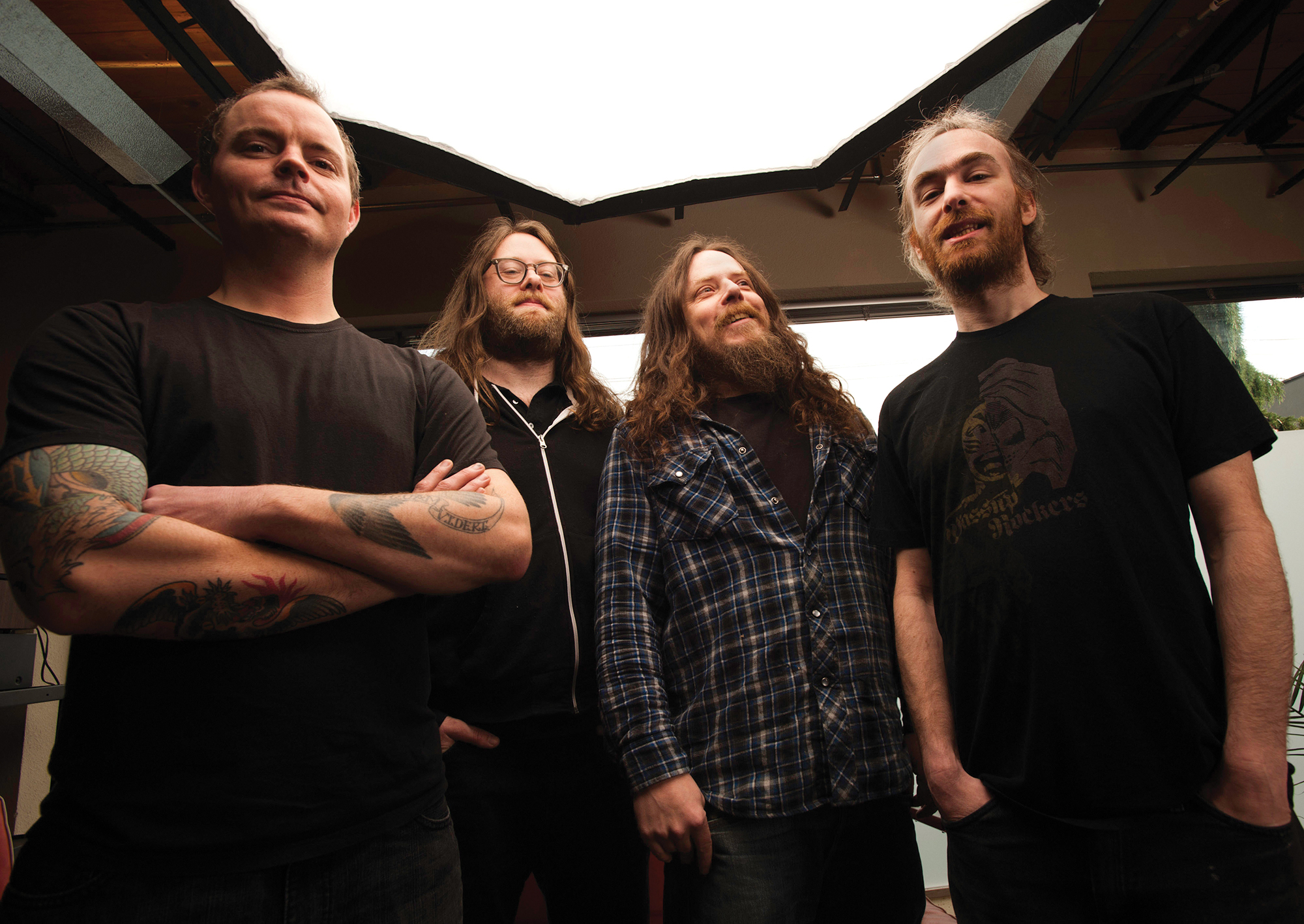
I was watching some of the Converse documentaries of Red Fang’s European tour… There were a few clips of you guys saying how few tickets you had pre-sold for the gigs, but then it would cut to the live concert footage and the venues were packed. Were you surprised at the turnouts?
I think Aaron said it in the documentary, and it’s true, people just don’t buy presale tickets for us so much. It’s a walk-up crowd. Although, that was only our third tour in Europe, so it’s not like we had a whole lot of experience…and having it be our first headlining tour, we had no idea what to expect. We were very pleasantly surprised. I think a lot of it was due to touring with Mastodon in the States in late 2011 and had already planned on that tour that our next European tour would be as a headliner, but I think three and a half weeks before Mastodon was going to Europe, they still didn’t have an opener. They asked us, and it didn’t really seem possible, but it didn’t seem like there was any way we couldn’t do it. A big reason [our headlining tour] was so successful was that we got to play in front of so many people. Mastodon is doing really well right now. They’re filling huge rooms, and we got to do main support from them all through out Europe. That was an awesome opportunity, and we went back like a month and a half later. It was really good timing.
When you were playing the Mastodon tour, did you see a lot of people in the audience who may not have been familiar with you being won over?
Sometimes it’s really hard to read a crowd. Sometimes we’ll play a crowd, and they’ll seem really sedate, but then you’ll look at how many T-shirts you sold, and you did better than when people were going batshit crazy. I don’t know. People appreciate music in different ways. There were definitely people who were looking at us the first three or four songs going, “Do I like this or don’t I?” It’s a challenge, that’s for sure. They’re not there to see you, they’re there to see Mastodon. It’s your job to convince them that they’re there to see Red Fang and Mastodon.
One other clip from the documentaries I liked was in the last part of the documentary when you were at a stop in Moscow, and you were looking at the Marshall stack you hadn’t used before.
There were so many buttons. I was like, “What the fuck?” Usually I can figure those things out. I just hit the button that makes it sound the most distorted and then turn all the knobs to the right, and that’s usually fine. And in that case, it was fine as well. Some Marshalls they’ve got that classic Marshall sound, but it just doesn’t work for us. It sounds more like AC/DC. It’s sort of a clean distortion. I like the real nutty distortion.
You’re going back to Europe in a couple months. Are you heading to places you didn’t hit the first time?
Yeah, we got invited to do All Tomorrow’s Parties, which we were blown away and flattered to be able to do that. It’s curated by Shellack, who I’m a big fan of, so we built a tour around it. Just getting over there is pretty expensive. You make a tour out of it so you can rationalize going all the way over there. We’re doing that, and I think we get two days off, so we’ll get to enjoy that whole event. It’s a three-day festival. Another amazing thing we get to do is a BBC Session, so I’m thrilled and terrified at the prospect of that as well.
Why do you say terrified?
Well, it’s a studio without a net. I guess you get a couple of runs at the song, but it’s live, man. If you flub, it’s out there, and people know it because it’s studio quality.
It sounds like a nice trip. It must be nice to have a couple of days off this time, too. Last time around it was 33 shows in 35 days. It didn’t seem like you had too much time to take in the sights.
The last tour we did before that, I think we had one day off, and that was a longer tour. We’re finally realizing we start going crazy if we don’t get a day off here or there, so the two days off on the last tour were very intentional. Where would be the most relaxing place to be, and what the shortest drives to and from would be, so we could maximize those days off. I think our second day off was in Budapest, and we got to go to the hot springs, the baths there, and it was a full-bore vacation day. It was really nice. I hope that trend continues.
You might as well enjoy yourselves.
You’re in some beautiful city and you show up for sound check–I like to call the club “the black hole,” because once you walk in, it’s almost impossible to get out and see the sights or anything, because you end up having to do stuff.
From your music videos, I saw that PBR was featured pretty heavily. While you were in Europe, were you able to find a cheap beer equivalent?
The swill you mean?
I was trying to be diplomatic.
No, but the clubs found it for us. We’d say, “We need a lot of beer,” and they’d be, “Alrighty, what’s on sale?” But truthfully, I think they take their beer pretty seriously over there, so even their bad beer is pretty good. My only complaint is that sometimes the inexpensive beer has a stronger flavor, and they’re not really into cold beer, they’re into cool beer. So when it’s not your favorite, you can really taste it when it’s floating around at 60 degrees, in a can to begin with. You’re like, “Oh yeah…beer…”
You won’t want to miss Red Fang and Black Tusk when they play Harlow’s in Sacramento on Oct. 26., 2012 It’s the band’s first stop on their latest U.S. tour, so help them kick it off in style. Lord Dying will also perform. Check with Harlows.com to purchase tickets. Listen to “Crows in Swine” at http://soundcloud.com/RelapseRecords.
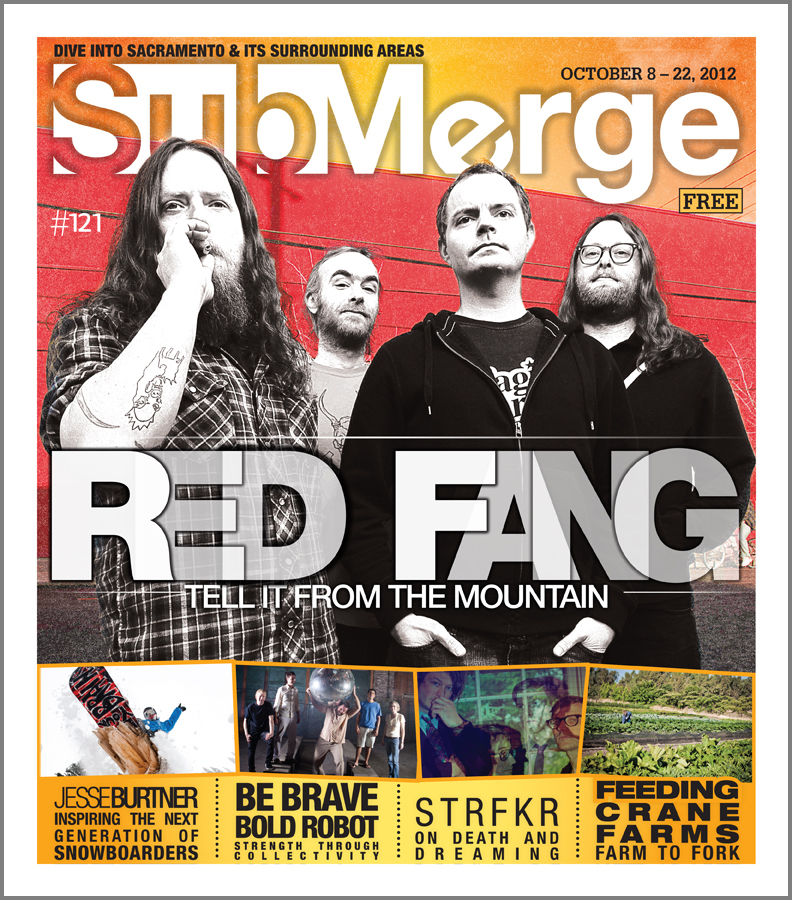
For a wide swath of the country’s electronic music lovers, Portland’s Starfucker is a bit of an anomaly. Consider first the group’s somewhat reluctant allegiance to its own name. The edginess of the Starfucker moniker had in fact started as a sort of rough experiment by primary songwriter Josh Hodges to see how far, if at all, such an abrasive handle could go. Before they could find out, the band made a publicized switch to the name Pyramid, which was soon after morphed to Pyramiddd.
Undeterred in the crossover was the project’s loyalty to deep house beats, swelling synths and clunky pop guitar lines, helmed by Hodges’ battery mates Keil Corcoran (percussion, drum machine), Patrick Morris (guitar) and Shawn Glassford (bass). For all those club-ready beats, however, appeared Hodges’ decidedly macabre fascinations with death, dreams and all things dark, providing a brooding insight to a gifted and perhaps troubled sort of modern songwriter.
The band returned to its original name of Starfucker in 2010–though they augment it arbitrarily to STRFKR depending on the phases of Jupiter’s moons (kidding)–no worse for the wear, and have finally put all that goddamn name rigmarole behind them.
Reptilians, released in 2011 on the Chicago indie label Polyvinyl, is Starfucker’s most ambitious album to date. Reptilians continued Hodges’ sweeping new wave melodramas with auditory bits of pop-rock panache, typically morbid lyrical swipes and snippets of lectures by famed British philosopher Alan Watts. The album was the first for the project that included a more collaborative approach between all of the band members, though to pinpoint at which intervals would have been difficult given Hodges’ somewhat ironclad creative grip.
A year-and-a-half removed from Reptilians, Starfucker is hitting the road again for a fall tour at the tail-end of engineering their second release for Polyvinyl–an as-yet-untitled, 15-track LP that Hodges explains is similarly dark, similarly upbeat and plain old similar to his band’s prior output. It’s a good thing, then, that said previous output is so unfairly catchy. To boot, Hodges tells Submerge that Starfucker’s new album–to be released in February 2013–is the band’s most collaborative effort to date.
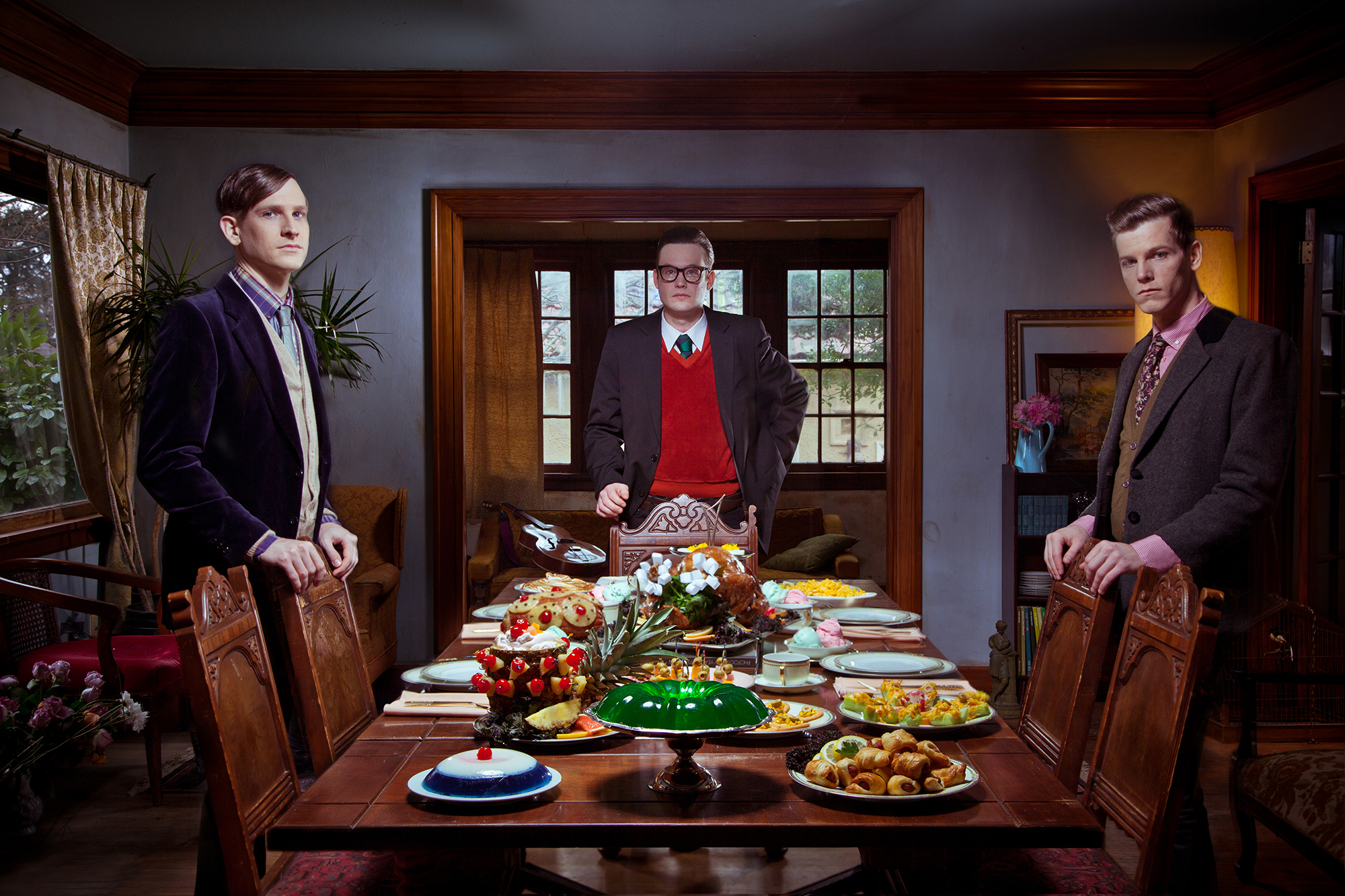
Reptilians dealt with a lot of darker kind of imagery, but retained an upbeat, dance-y ambiance throughout. As a songwriter creating through a pop prism, how do you reconcile that dichotomy?
I think they go together well. Every one of our albums has been like that, but this new one is probably even darker. I just like to write about what I think about, which is death and change. The way our society is, and the way we all think about living is silly considering how people often say, “Oh I would have changed things if I’d known I was gonna die, and not cared about so much bullshit.” We all know [we’re going to die]. In one way or another that’s what the lyrics are always about. I mean, it’s still fun to dance. When I started Starfucker, I was bored of going to shows. The way that it’s interesting is if you can dance–even if you’re into the music–you can still have a good time. Or if you don’t dance, and end up at a dance-y show with your friends, the music is still songs you can listen to that are saying something and not just techno music. The songs are definitely focused on making music that’s fun to play live. I think they go together well, to talk about potentially dark things and then have music be lighter or hopeful. I’ve always liked that and like when other artists do that.
Did you grow up listening to electronic pop bands that had that more cerebral, thematic motif?
I didn’t really. I didn’t like electronic music when I was growing up. I just got some keyboards and thought, “Oh this is actually really cool.” I think I always liked darker music. I think with Starfucker, a big part of it is listening to it at home and reading the lyrics, but then a lot of it is emphasis on the live show, and on living right now and getting a break from the boring stresses in life. It’s nice to go to a show and forget things for a minute, especially if dancing is your thing.
Have you had conversations with fans of the band, where they were into that same contrast? Like maybe they weren’t exactly privy to the darker lyrics, but more reeled in by the dance-y music?
Yeah, definitely. That’s one of my favorite things about having this project is talking with people who come out. I always hang out after shows and talk to people at the merch table or write to them on Facebook. I’ve met some really cool people and have had some really cool conversations with people about that. Also, just the little bits of Alan Watts on the album that’s started some really good conversations with people. I’ve had fans come up and say they’d never heard of him, and then they started getting into him. It’s cool to expose someone to something new like that. And it’s cool to have cool conversations with people about it [laughs].
I would imagine on tour, any time the conversation errs outside of “how’s the tour going?” must be refreshing.
Yeah, totally. It’s super refreshing.
What new fascinations or themes have you been focused on since Reptilians’ release that you may explore on your next album?
It’s a lot of the same stuff, just a different take on it. It’s a bit darker, but still really playful. There’s a lot of dream references in it, too. I had dreams where I was dying and laying on my death bed that seemed real. Patrick has really crazy dreams, too. I guess death and dreaming…
Is it a scenario where those themes are driving the direction of the music in any way?
Yeah, maybe. It’s still upbeat; it’s still happy. But there’s just a little darker stuff on this one than the other albums. It’s longer than the other albums, too. There’s more diversity. More than half of the album has more organic instruments on it, and not as much synth.
I wondered if you’d explore that more. On Reptilians, songs like “Born,” “Astoria” and the title track had a starker, avant-rock kind of sound. Is that a direction you can see Starfucker going toward more as a project in the future?
Yeah, I mean the first half of the new album I wrote a lot of the songs on guitar, so it has that kind of vibe. We’re adding stuff to it now. And I wanted to make part of the album have this super happy feel–we were calling it The Drunk Album for a while. It has a lot of really weird bendy guitars and stuff.
So there’s no reticence on your part to stray too far musically from the project’s primary roots in dance and pop?
Well, I still wanna keep it with the same basic idea, which is a happy, positive vibe. I wouldn’t wanna go too far away. I am a little bit hesitant. I think all of the songs on here are either dark and dance-y, or fun, but maybe not as dance-y. They all still have that playful vibe that I think is important.
For the last album, you allowed additional help from the rest of the band members to round things out musically on record. Are you taking that approach on this new record?
Yeah. This is definitely the most collaborative album we’ve ever done, and it’s been really fun. There are even two songs on the album–one Keil started and one that Patrick started. It’s really awesome. It’s still mostly songs that I wrote and then we fleshed out together, but even Shawn helped me finish words. It’s actually what I always wanted this to be: more of a band, and not just my project.
Are you finding that liberating, to allow this thing that was once mostly yours to become collaborative?
Yeah, it’s like being a parent. It’s nice to have more than one parent to raise the kids [laughs]. It’s nice that we’re all working together; I like that communal feel. We feel like family.
Can that more organic approach for the new album you were talking about before be attributed to that collaboration?
No, I have to fight for that. Keil hates anything not electronic. But I’m still going to do what I want if I have a song I really like. But we pretty much agree on everything at this point. The less electronic stuff, Keil just doesn’t get. He knows it though, and is like, “Well if you guys all like it…” It’s still pretty democratic. If someone really likes a song and fights for it, I’ll give in.
Get your gloomy dance on at Harlow’s Oct. 17, 2012 when Starfucker makes a stop in Sacramento. The show starts at 8 p.m. and tickets are just $15. Go to http://harlows.com/ for more info or to purchase tickets.
Blitzen Trapper Navigates Nostalgic Avenues on American Goldwing
The key word for the successes and attention over the last five years for Portland, Ore.’s Blitzen Trapper might have to be “patience.” With their conception in 2000 as a six-piece crew of classic-rock connoisseurs–anchored by the songwriting prowess of figurehead Eric Earley–Blitzen Trapper accidentally enjoyed an educational incubation period in garages and small clubs for a full seven years before anyone outside their hometown really had a clue or cared about them. With everyone seemingly looking the other way, the band honed their craft, wrote, recorded and released three albums on their own (2007’s Wild Mountain Nation would eventually be re-released on Sub Pop), and figured out, basically, how to be a band. With Wild Mountain Nation, Earley’s artistic prolificacy, and his isolation/inspiration of residing in the band’s actual studio space during the creation of the record, resulted in a buzz that’s ricocheting even today, complemented greatly by the 2008 follow-up, Furr, and the slightly prog-y 2010 LP Destroyer of the Void.
Blitzen Trapper’s latest release, American Goldwing, is a return to the nostalgic confines of road-weary rock, rumbling with gobs of groove, walls of squalling guitars and Earley’s typically brilliant strokes of capturing the nomadic spirit on tape. Big riffs and catchy choruses abound, showcasing a band maturing a mere 12 years after they first played a note. With the band’s ascent into the consciousness of media heads and music lovers alike having coalesced to form a formidable army of devotees, the band is capitalizing on their impeccable sense of timing yet again, hitting the road for another run of dates that will slither them out of the clubs and into the maw of the festival circuit through the spring and into summer. In anticipation of Blitzen Trapper’s gig at Harlow’s on March 5, 2012 guitarist/vocalist/keyboardist/melodica player Marty Marquis spoke with Submerge via phone from Seattle, where he was slated to headline at his friend’s wedding ceremony.
The band’s been off the road for a while now. How do you relax off tour? Do you tend to hibernate away from each other?
We hang out and do stuff now and again, but for the most part I think everybody’s got their own lives now. When we’re on the road, we enjoy each other’s company, but it’s nice to have a break from the enforced intimacy. I’ve got kids now; our bass player Mike [VanPelt] just had a kid a month ago. The other guys have their own things going on, too. When we started playing together in 2000, we weren’t like, “Let’s make a band and get famous and make a bunch of money!” We just liked hanging out, so we’d spend four or five hours a night, three or four nights a week. We did that for years, just hanging out, playing and recording. We’ve logged a lot of time with each other. We don’t feel the urge to do it all the time anymore.
Do you feel like folk, roots or Americana music is being homogenized by its resurgent commercial popularity? If so, is a band like Blitzen Trapper fearful of a backlash?
The thing to look at is how much of this music is actually folk-Americana music, and how much of it is just the trappings of that. I was hanging out with this guy last week, and he was talking about Mumford and Sons was Journey with banjos and acoustic guitars. There’s nothing wrong with that, but it’s just funny I guess. In the [late] ‘60s, no matter what style of music you were playing it was important to have long freaky hair and wear peace signs or have a fuzz guitar, making your music psychedelic regardless of where you were actually coming from musically. So bands are responding to all kinds of different pressures, and I think especially young bands who are talented but don’t necessarily have much of a sense of identity are apt to go for those folk-Americana trappings.
I don’t know about backlash. I feel like everything is so fragmented and Balkanized in music that it’s hard for me to imagine people being like, “Oh, we’re sick of this folk-Americana stuff!” There are a million other subgenres you can get into that will sell just as well probably.
Eric Earley has said that American Goldwing was written and at least partially recorded during your tour for Destroyer of the Void, and that it was hard playing the current songs when he knew that American Goldwing was the “real” record. Was that the sense for the rest of the band, or had you even heard those songs yet?
We’d heard a bunch of them. In my recollection, I think Goldwing was about half-done when we took off on tour for Destroyer. That’s been Eric’s motive; he’s ultra prolific. If he doesn’t actively stop himself from writing and recording, he’d be recording all the time. There were a lot of different things going on around the time we were putting together Destroyer. One of the things we were trying to do was build a consensus with all these different players–the band members, our label, our management–about what the record was supposed to be. I think because Destroyer wasn’t necessarily well-received, it was sort of easy to say that was a bad approach. It didn’t really represent what Eric as an artistic director was going for. He felt like Goldwing was a lot stronger of a representation of who he is as an artist, musician and songwriter. He felt great about the songs that were on it. On an objective level, the songs on Goldwing are coming from a more honest place than anything Eric’s ever put out before. It’s more about his life and less about fantasy stuff.
As a band, then, how do you reconcile that underlying feeling of having such a great album waiting on the shelf and you’re not able to play it because you have to tour for a different record that you worked on just as hard?
I think there’s always that thing where as an artist, you’re always most excited about what you’re currently working on. But there’s a delay in the music biz where your record comes out six or nine months after it’s finished. So you wrote these songs maybe a year or two before. You’re thoroughly familiar with them and you’re kind of tired of them. And then if nobody else in the world seems excited about these songs, it’s even more tempting to want to move on to the next round. But I don’t think that this narrative of American Goldwing being the “real record” is anything that all of us were thinking when we were touring on Destroyer.
I know Eric writes a majority of the songs, but what collaboratively is happening in the creative process? How informative are you in those processes when recording and writing, and the rest of the band as well?
I’m not very important at all in the writing and recording process. I came in on Goldwing and sang on some songs, but I didn’t play any guitar or anything. Brian [Koch], our drummer, was a lot more instrumental in arranging these Goldwing songs. I think he was a big part of why those songs turned out the way that they did on the rhythm side. I think also there’s this–I don’t know if it’s subliminal or what–but if you’re playing stuff in the van when we’re on tour, Eric’s going to pick up on it and incorporate elements of what he’s hearing, whether or not he realizes it. We’ve been talking about aesthetics and rock ‘n’ roll philosophy for a decade now, so I think we’ve all really influenced each other and been informed together. Also, I think while Eric’s in the studio arranging these things he’s thinking this stuff is going to be represented live by these players, here’s what they do well. He’s arranging these songs and thinking in terms of who we are as a band, as individuals. That’s not strictly collaborative, but I think it still affects the way the songs turn out. The more we go along and become a band, and it sort of crystallizes as a creative performance unit, the more it affects the way the songs end up on the record.
Is there a song that encapsulates the universality of that theme best on this record in your opinion?
Yeah, I think the title track is a pretty awesome song. It’s got a lot of abstract imagery, but it’s about travel, and the willingness to get on a vehicle and go. There’s sort of the spiritual thing that’s built into that song in particular, where the will to travel and the will to move places is somehow spiritually refining. But I think probably the best song on the record is the last one, “Stranger in a Strange Land.” It’s kind of the flip side of that: Once you stop moving, you don’t know where you are.
Catch Blitzen Trapper live Monday, March 5, 2012 at Harlow’s. Opening will be excellent alt-country Portland group The Parson Red Heads. Show starts at 8 p.m. and tickets are $15 in advance. Visit Harlows.com for more information.
Y La Bamba’s Luz Elena Mendoza Moves Forward
All sound is building. That doesn’t mean music can’t be original, it just means influence is a given. It’s how you interpret that influence that makes something original. Take Y La Bamba, for instance. The sound–self-proclaimed gypsy-pop, press-reputed art folk–embodies a certain sacredness. The meld of dreamy percussion, staccato swells of accordion, guitar licks evoking traditional Mexican songs, all move as one, almost with a ritualistic sense. The most enchanting part is the voice of Luz Elena Mendoza; her loose webs of harmony and vocal flutterings tapping notes all over the register. She seems in a trance, like she’s merely a medium, channeling these noises. In some ways, it’s true: She’s a medium for her influences. Mendoza grew up spending summers in Northern California orchards with her family and a larger Mexican community. There were a lot of parties with many musicians, during which Mendoza would see her father perform freely.
“He would be the only one in the family to have that musical drive,” Mendoza said. “I saw him kind of be out of his body, and for me to be little and grow up and see that, I guess I was just trying to tap into that, naturally that kind of stuff just finds you.”
Those early summers were the basis of Mendoza’s musical foundation, of seeing “the passion, the rawness, the expression,” she said.
As an adult, Mendoza relocated to Portland, Ore., her current home base, along with her cat, Bamba, who unintentionally became the reason for her band’s name.
“I made up a moniker, Y La Bamba, me not being present, and the cat,” Mendoza said.
The band has now grown into a six-piece group, with Mendoza still writing the skeletons of each song, filled into full-body sounds by her band mates. The group is currently on a West Coast tour, recently having made their first stop in Seattle, where Mendoza takes a minute to answer all these questions and reflect on her Northwest home.
“Since I’ve been living in Portland, I’ve just been becoming my own, and definitely have my roots within my core,” Mendoza said. “Everything I do with music, I see the image of my father and my mother and my ancestors. But because I live up in Portland it’s been hard in the last few years of my adult life to be connected to my ethnicity, the traditions my family had.”
Despite the distance from her early roots, Mendoza’s been lucky to fall into the arms of the growing musical body of Portland, that beautiful Northwest hub of artists in a forest. Soon after she began playing music around the area, Mendoza was lucky enough to have her first album, Lupon, produced by The Decemberists’ guitarist Chris Funk, and released by the quickly budding Portland-based label, Tender Loving Empire.
That northwestern tip of Oregon is quickly becoming a strong presence on the country’s map of music, thanks to some talented heavyweights like Modest Mouse’s Isaac Brock, The Decemberists’ Colin Meloy, M. Ward and others.
“Portland’s really cool like that, there are so many musicians, a lot of people that have made a name for themselves outside of Portland,” Mendoza said.
However, it’s not just the bigger successes who give Portland its sonic reputation, it’s the community itself. Artists actually supporting other artists.
“Because Portland is such a music Mecca, it’s not hard to go out and play a song at a local pub and have people support you, and all of the sudden people supporting your vision, it just naturally happens,” Mendoza said.
Not to be misled, Portland may be becoming the land of milk and honey, but not in a lucrative sense, more in the way of ample human resources, most importantly, support.
“It’s not like we’re all making a whole shit-ton of money,” Mendoza said. “It’s not like something you seek out, it’s like dinner’s ready, just sit down and eat.”
After the success of Y La Bamba’s first record, Lupon, many things began to come to light about Mendoza’s past, one being an excruciating period of her life when she contracted amoebic dysentery and giardia while traveling at a young age. The illnesses took a gigantic toll on her overall health and resulted in substantial weight loss and depression. The repercussions of that experience are very much present in Lupon. However, despite their being at the lyrical forefront, they’re still tender wounds for Mendoza.
“I know you could sit there and talk about it like, ‘We need those things, they’re allies in later life,’ but for me they really stick in my spine,” Mendoza said.
When she first arrived in Portland, Mendoza was still very much suffering from her sicknesses, which bled into a lot of her interviews and musical demeanor.
“All of those things are part of my quilt,” Mendoza said. “Anything that creates a chip on my shoulder is going to be more prolific for me to explore.”
But now, Mendoza is ready to lay those things aside and grow from them. The newest Y La Bamba installation, Court and Spark, set to come out early next year, is produced this time by the recent Portland transplant, Steve Berlin, band member of Los Lobos.
This album devotes a larger chunk to her roots, with more tracks sung in Spanish.
“There’s way more songs in Spanish. It’s not like I was trying to go for that, it just kind of naturally happened,” Mendoza said.
Despite its subconscious appearance, keeping that presence in the Y La Bamba sound is something that’ll be protected.
“Writing in Spanish is something I don’t ever want to forget; I feel like I’m speaking from my ancestors,” Mendoza said.
Beyond her past, Mendoza is ready for forward action, to keep ties to her influences and what’s essentially made her present, and move on.
“For those who are totally hungry for growth, everyone has their own interpretation, but my intention when I wrote those songs was to simplify my mind, and if that’s healing to others, I just want the audience to know that’s there,” Mendoza said.

Y La Bamba will play Luigi’s Fungarden in Sacramento on Friday, Nov. 18, 2011. Also performing will be Death Songs and Armando Rivera. Show starts at 8:30. Look for Y La Bamba’s forthcoming new album early next year.
A Submerge guide to pumpkin libations
Words by Adam Saake – Photos by Nicholas Wray
Hey look! It’s fall. Oh, there it goes. Living in Sacramento, you know that fall makes a quick appearance yet there are so many ways to indulge. Having your checklist done early, your Halloween costume pre-ordered and a trip to Apple Hill in permanent marker on the calendar is a good start, but there are still a few things that fly by under the radar. Pumpkin beer is one of them and if you’re not quick to grab a six-pack off the end cap, you might miss out on some limited edition suds that can be quite delicious. What once seemed like a novelty has now become a tradition for some serious beer drinkers and the choices have multiplied. Ales, lagers and even ciders are popping up on the shelves and each offer unique takes on the flavors that this iconic orange squash has to offer.
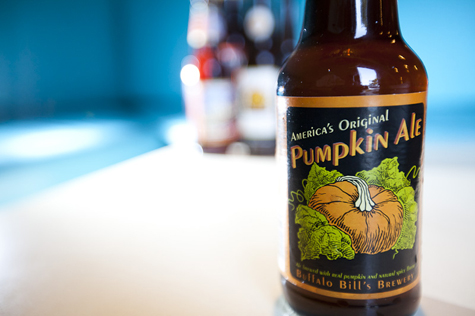
America’s Original Pumpkin Ale
Buffalo Bill’s Brewery, Hayward, Calif.
Buffalo Bill’s Brewery offers a quality pumpkin ale that is firmly centered on drinkability and not necessarily pumpkin overload. Not to say that pumpkin isn’t the focus here, but on a scale of Linus to Return to Oz, this is somewhere in the Silver Bend Pumpkin Patch. The first initial sips yield the pumpkin and then the luster slightly fades, but still very refreshing. Clocking in at a little over 5 percent alcohol and 11 IBUs (international bittering unit), even grandma might have one with you to celebrate the holidays.
The Hayward, Calif.-based brewery who are also known for their Alimony Ale and Orange Blossom Cream Ale have had their feet in the microbrew market since 1983. These guys definitely know what they’re doing with their pumpkin beer, so you’re safe to grab a six-pack and enjoy.

Blue Moon Harvest Pumpkin Ale
Blue Moon Brewing Co., Golden, Colo.
Surely the most recognizable name we’ll mention here in our Pumpkin Beer spotlight, and either you love it or you hate it. Blue Moon, a Miller/Coors product, hit the scene around 1995 at The Sandlot Brewery in Boulder, Colo. (then just owned by Coors) and it didn’t take long before it had made its way into many watering holes around the country.
Originally launched in 2006, the Harvest Pumpkin Ale has had a facelift this year and according to Miller/Coors has been “re-launched and reformulated this year.” What does that mean? Well instead of brewing the beer with just pumpkin and cloves, they add nutmeg and allspice as well. That and the label become a little less artsy and lot more branded. What you get is a quite enjoyable beer with a good body, smooth finish and great balance between the hops, pumpkin and spices. Coming in at 5.7 percent alcohol, Harvest Pumpkin Ale is a step up in intensity but not overpowering and certainly a beer you can enjoy more than one of.

Pumpkin Lager Beer
Lakefront Brewery Inc., Milwaukee, Wisc.
Located on the Milwaukee River in Milwaukee, Wisc.–pronounced mealy-walk-ay if you’re Alice Cooper–Lakefront Brewery has been crafting quality microbrews since 1987. The brewery itself is a huge tourist attraction to the point where sold-out brewery tours gave way to online ticket sales. Still independently owned and cranking out large volumes of beer, boasting over 20 different selections, Lakefront is testament to the little guy doing big things.
Their Pumpkin Lager Beer, apparently inspired by a Thomas Jefferson recipe that brewery owner Russ Klisch stumbled upon, is as close to pumpkin pie in a beer form that you might find. Pour one into a glass and you’ll immediately notice that the nose jumps out; heavy with pumpkin, cinnamon and clove aromas. The mouth feel echoes the nose; rich yet goes down easy and the use of Caramel and Munich malts lend to the texture and depth of this fun drinking beer. Slightly copper in color and 6 percent alcohol, you might spill a few family secrets after a few of these.
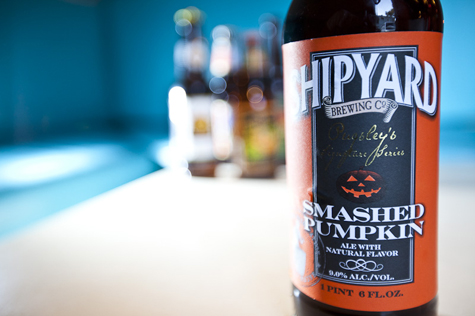
Pugsley’s Signature Series: Smashed Pumpkin Ale
Shipyard Brewing Co., Portland, Maine
Caution: double entendre approaching! Shipyard Brewing Company’s co-founder and Master Brewer Alan Pugsley has outdone himself with this Smashed Pumpkin Ale. Not only will you be “smashed” after a few of these, but your head will feel like Gallagher took his sledgehammer to it in the morning. Packed with so much spice, pumpkin, hops and malts and 9 percent alcohol, this pumpkin beer is truly a trick and a treat. Submerge asked local beer guru Mark Neuhauser of Pangaea Two Brews Cafe what he thought and he called it “very sweet…pumpkin pie in a bottle.” Pugsley uses three different malts including Pale Ale, Wheat and Light Munich along with two different kinds of hops; Willamette and Hallertau. The high alcohol gives it the backbone and bite, making this beer perfect for any of your spice filled holiday foods.
Of course, it’s no surprise that Shipyard would blow the stem off the pumpkin beer category. These guys are known for amazing craft beers that they’ve been perfecting since 1992. They’re Maine’s largest brewery that also makes Capt’n Eli’s Soda, a craft soda that comes in seven different flavors and are the 19th largest craft brewery in the country. All that from little ol’ Maine, go figure. On top of that, Pugsley is kind of a rock star in the East Coast microbrew world. Back in the ‘80s he bounced around and helped establish quite a number of breweries as well helped design and build breweries in the United Kingdom.
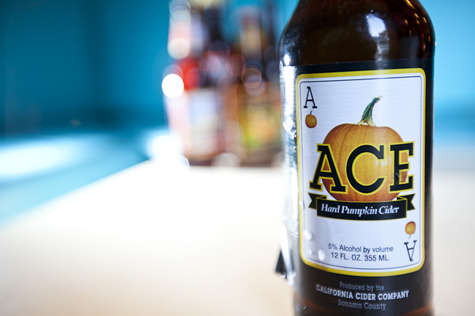
Hard Pumpkin Cider
Ace Cider: The California Cider Company, Sebastopol, Calif.
Alright, here’s your wild card. Ace Cider based out of Sebastopol, Calif., has been making cider for 15 years. Before there were really cider options, there was Ace and over the years they’ve stayed amongst the companies making really high quality, gluten free and delicious ciders. This year is the first year that the company has released their Hard Pumpkin Cider, an apple-based cider that is blended with pumpkin and allspice. Jeffrey House, owner and master cider maker, says that he made 10,000 gallons this year and it’s already all gone.
“People are racing to drink it,” says House.
With the popularity of the product, House says they’ll more than likely double or even triple production next year to meet the demand. The cider is quite a unique product that doesn’t scream pumpkin but merely suggests it. The allspice is subtle and you pick up the apple on the finish along with an interesting aftertaste reminiscent of pear candy. This cider is 5 percent alcohol and quite low in sugar content, 9 grams per 12-ounce bottle. If you’re really aiming for pumpkin, I’m not sure if this is for you but overall a tasty cider that fits in perfectly with their existing line.
These beers and ciders can be found at Total Wine, Whole Foods, Corti Bros and other select specialty markets. Call ahead because they are seasonal and will disappear quick.
Still thirsty for more pumpkin beer? Pangaea Two Brews Café has Dogfish Head’s Punkin Ale on draft. Pangaea was lucky enough to acquire three of the six kegs allocated to the entire Sacramento area, so get it while it’s here. Or, head over Alley Katz and try a Double Pumpkin Ale on draft from Sam Adams.
A Lot Like Birds Readies The Release of Conversation Piece
It’s a quiet Tuesday night in Midtown and local progressive/post-hardcore band A Lot Like Birds has 80 or so fans packed into Luigi’s Fungarden as they tear through songs off their upcoming Doghouse Records full-length debut Conversation Piece, set for release on Oct. 11, 2011. Songs like “Think Dirty Out Loud” and “Sesame Street Is No Place for Me,” the album’s first two singles, have the crowd feverishly swaying back and forth to their spastic and energetic rhythms and riffs. Co-vocalists Cory Lockwood and Kurt Travis bounce around the small stage, shaking their long locks, taking turns singing and screaming, fully taking advantage of having co-vocalists (think call and response, harmonizing, layering, etc).
“I’m not the singer and he’s not the screamer,” Travis makes known as the two vocalists and I share a pitcher of Pabst Blue Ribbon at a local watering hole the Friday following the show. It quickly becomes apparent that this is an important point for them to get across. “We’re both vocalists,” he says. “I scream and I sing. And he screams and he sings. And we yell and we talk and we do spoken word. We do everything, we do all of it.”
Lockwood agrees and thinks of it like this, “I feel like a lot of times with dual vocalist bands that have a singer and a screamer, you’re diverging your fans and you’re going to have people that go, ‘Well I listen to the singing,’ and then you’ve got the guys who want tough music and they’re like, ‘Well I like the screaming.’ So if you bleed both of them, you’re forcing people to like it as a whole.”
Couple the outrageous and entertaining vocal work from Travis and Lockwood with the equally impressive instrumental work of the rest of the band, which consists of guitarists Michael Franzino and Ben Wiacek, bassist Michael Littlefield and drummer Joe Arrington, and you’ve got yourself one interesting record in Conversation Piece. One that crosses genres, tears down boundaries, leaves the listener wondering, “What’s next?” after each track comes to a dramatic close, and one that will most likely take a few listens to grow on you. They are aware of this.
“I know that music like this has to grow on people. People are really slow at picking stuff like this up,” says Travis.
“It’s almost easier for us to do weirder stuff,” Lockwood admits.
And weird it is, although we’re not talking about an un-listenable type of weird here; this isn’t just random noise after all. We’re talking about calculated time signature changes, non-traditional song structures, heavy-hitting breakdowns mixed with luscious reverb and delay-ridden clean parts, impressive and off-the-wall guitar riffs and interesting lyrical content to boot. Take the following lines from “Think Dirty Out Loud” for example, where Lockwood screams, “I spiked both our drinks with a gallon of ink / Now I’m writing a novel from your insides / We’re a spider with our limbs doing anything but walking / A conversation with our mouths doing anything but talking.” Or where Travis sings, “I eat emotional wrecks / And yours is the best.”
“I remember the instance in which we started writing the lyrics,” Travis says of the song. “I was totally enjoying myself, just laughing to myself, just thinking I’m the most clever fucking person ever.”
It is noteworthy to point out that in a number of ways, Conversation Piece is entirely different than A Lot Like Birds’ last offering, 2009’s Plan B. The latter was largely the work of guitarist and songwriting catalyst (as well as the band’s original vocalist) Michael Franzino, who invited a horde of local musicians to play everything from trumpet and trombone to cello and violin on the record. Plan B didn’t even feature a live drummer, as Franzino programmed the drums himself via computer. Conversation Piece is much more of a collaborative effort and consists of mostly the band’s core instruments (guitar, bass, drums, vocals), although it does contain some programmed stuff (“A Satire of a Satire of a Satire is Tiring”) and a little bit of horns (“Vanity’s Fair”) as to not depart completely from the band’s tendency to blend live instrumentation with orchestral and programmed elements. One of the most obvious differences between the two records is the solidified lineup, which includes the recent addition of Travis, who up until this summer had spent the last couple years co-fronting another Sacramento-based post-hardcore band, Dance Gavin Dance. “There’s four new members,” Lockwood says of the post-Plan B lineup. Travis interjects, “I’m not the new guy, you know what I mean? I’m the newest by all means. But Plan B was pretty much one or two guys, now this record is everybody giving their opinions and whatnot.”
For the recording of Conversation Piece, A Lot Like Birds turned to Portland, Ore.-based producer/engineer Kris Crummett, a familiar face to Travis, they have recorded two DGD albums together (2008’s self-titled record and 2009’s Happiness).
“As soon as I got kicked out of Dance Gavin Dance, Kris hit me up and was like, ‘Let me know what you’re doing, whatever you do, just let me know,’” Travis remembers. “It was kind of interesting because when I joined A Lot Like Birds, they were already talking about and thinking about going with Kris Crummett. I love that guy, we have a good history; we have a good thing going on.”
The band worked rigorously with Crummett for three weeks, focusing all of their creative energy on the record, which wasn’t even necessarily completely written yet, as Travis and Lockwood both had a fair share of lyrical work to do while in the studio.
“Everybody was hella trippin’, but that’s kind of how I like to work anyways,” Travis says of the high-pressure situation to complete basically half an album’s worth of lyrics on the fly. In the end, things worked out beautifully for the two vocalists, who found themselves locked in a room with Crummett for hours on end, pounding out vocal ideas together.
“I don’t think either of us had any idea how well we were going to work with each other,” Lockwood says of co-writing. “I’ve never worked with another vocalist before.” Travis pointed out that because the group was away from the everyday distractions that come with being home, they were able to channel everything they had into the record. “When you’re in your home town and you have all your stuff, you know, you have your job that you go to, you’ve got your girlfriend, you’ve got your parents and all this stuff. Sometimes it’s distracting,” Travis says. “I hella missed that when I was a full-time touring musician. You kind of just focus on music. So when I got to Portland, I was just kind of like, ‘Ah, I don’t have to think about anything other than just this record,’ and it got all of our attention.”
Even still, the band didn’t finish everything they needed to in their allotted time with Crummett, and they had to record one song in Sacramento with friend and sound engineer Chris Miller. Crummett was still producing even from hundreds of miles away, though, as the band Skyped him during the sessions with Miller.

“He was still there like being able to hear the takes,” Travis says with a chuckle at the thought of Crummett’s face on a computer screen in the room for hours on end.
“He was just like eating Chinese food and shit,” Lockwood says through a laugh while air shoveling a bite of imaginary food into his mouth.
After three weeks spent in Portland with Crummett and a couple more days’ worth of sessions with Miller in Sacramento, the record was finally done, or so Travis thought. “Knowing my luck, we do like two days with Chris and then we get everything done and we’re like, ‘Yes! Fuck yes, it’s done,’” Travis says. “And then I get a call from my guitar player and he’s like, ‘You’ve got to come back and do some more stuff,’ and I was just like, ‘Dude, when is this going to end? We’re not even in Portland anymore.’ But it was completely worth it and the song came out way better than I even thought it could.”
In between the Portland and Sacramento recording sessions, A Lot Like Birds even found time to embark on a week-and-a-half long West Coast tour. It proved a good opportunity to work out the brand new material in the live setting and to gauge people’s reactions to it as well. “It was really like a testing the waters sort of thing,” Travis says. “To see who gives a shit right from the get-go. It was a good response!”
Lockwood recalls one particular night in Anaheim when a girl came up to him at the merch table after the show and told him that she hadn’t heard music like theirs in years, since the early ‘00s. “That’s definitely when I started playing music, that’s when we both started getting really into it. So if anything, if we draw comparisons to stuff from back then, that’s all I’d love to hear.”
Unfortunately for A Lot Like Birds, references to the sounds of the early ‘00s aren’t the only comparisons they’re receiving, as a large number of people (mostly via the Internet) are saying they sound too much like Dance Gavin Dance. No doubt there will be comparisons: both bands are from Sacramento, both have two singers, both have ripping guitar players and rock-solid rhythm sections; heck, they even recorded with the same producer, so yeah, sonically speaking there are some similarities too. But what’s funniest to Travis and Lockwood about the whole situation is that these quick judgments are coming from the album’s two singles, because those are the only two songs off Conversation Piece that the general public has heard.
“People have been really quick to go, ‘Oh, this is what their whole album is going to sound like,’” Lockwood says.
“They don’t even know how versatile it is,” Travis contends. “You know how the Internet goes; people are very, very quick to judge. It’s funny, it’s almost tickling. They have no idea. It’s going to be cool, because they’ll realize it when it comes out.”
Travis also wanted to get off his chest how he feels for Lockwood, who seems to be receiving the brunt of the reviews. The problem? Apparently he screams too much like Jon Mess, DGD’s co-vocalist. “Dude, if you have ears, you would know that it’s completely different,” Travis demands. “Their screaming styles are completely different. It’s just kind of like Jon Mess is the only person they can reference. It’s so funny, like when people compare me to Jonny Craig [DGD’s original vocalist who replaced Travis when he re-joined the band this year], it’s like, ‘Are you fucking retarded? Do you actually have ears? Because I sound nothing like him.’ Not that I couldn’t sing Jonny’s stuff and not that Jonny couldn’t sing my stuff, it’s just, we don’t sound alike. It’s the same thing with Jon Mess and Cory, and I just feel for him.”
Travis has gotten his fair share of attention, too, ever since his departure with DGD. “It’s just something that you have to deal with,” Travis says of constantly being asked about his situation. “It’s like one of those things about your job that you hate but you have to do anyways. I kind of relate it to that, because no I’m not upset, no I’m not tired of it. It’s just one of those things that I know that I’m always going to have to address and that’s fine. If I didn’t have all of that then I wouldn’t have any of this amazing stuff that’s going on right now. So, I think of it that way. Not like, ‘Oh man, I don’t want to talk about the past.’ All of that shit needed to happen in order for this amazing stuff to happen. I look at it like that so I’m not upset when someone is like, ‘What was it like? You got kicked out! Blah blah.’ I’m like, ‘Yeah, I did, but things worked out.’” And if you’re wondering, everything is cool between all the members of DGD and A Lot Like Birds. So much so that the two bands will share the stage together on Thursday, Oct. 13, 2011 at Sacramento State’s University Union.
After weeks spent listening to an advanced copy of their new record, an hour spent over beers at a local pub and a killer live set witnessed, it’s apparent to Submerge that A Lot Like Birds are their own band with their own identity and their own sound. Conversation Piece is no doubt the record that will solidify that and as of right now, getting the album out and into the hands of people who care about it is the only thing on their minds. With a grin from ear to ear, Travis says, “I think things will pop off real fast once that happens.”
A Lot Like Birds’ Conversation Piece will be out on Oct. 11 via Doghouse Records. See them live at Sacramento State’s University Union Ballroom alongside Dance Gavin Dance on Oct. 13. Sacramento’s own Ten After Two will also perform. Tickets are available at the University Union Box Office.
Consider the Slate Cleaned
Jaguar Love is something like a post-rock supergroup, if such a thing were to exist. Two parts The Blood Brothers and one part Pretty Girls Make Graves, Jaguar Love toes a difficult line between occupying the niche carved out by the sum of its parts, and breaking that mold to explore new territory.
“I think it makes it easier and harder,” says vocalist/pianist Johnny Whitney, formerly of The Blood Brothers, of starting a new project after the demise of his well established previous band. “It’s easier in the sense that when we started the band, it was really easy to get people’s attention, and it was really easy to get shows and getting a record deal wasn’t hard for us, because we already had connections in place from our previous bands. It’s difficult in a sense that no matter what people have, they come to it with their own expectations.”
Whitney didn’t have much time to brood over his next move. The carcass of his former band was still quite warm when he and fellow ex-Brother, guitarist Cody Votolato, began writing new songs for what would become Jaguar Love. In June, Pretty Girls Make Graves multi-instrumentalist J Clark soon joined in and the trio moved to Portland, Ore., where they started putting together material in June 2007. Though fans’ expectations were somewhat of Whitney’s concern when embarking with the nascent Jaguar Love, it wasn’t a problem he hadn’t faced before.
“It’s the same pattern that The Blood Brothers always struggled with,” he explains. “People who liked The Blood Brothers always wanted us to keep sounding like the record they got into us as. Like, when we were doing “¦Burn, Piano Island, Burn, they wanted us to sound like March on Electric Children; when we were doing Crimes, the wanted us to sound like “¦Burn, Piano Island, Burn.
“I’m happy to have a built-in fan base, no matter what, because of my old band, but at the same time, I’m not going to say that it wouldn’t be rejuvenating to start with a completely clean slate.”
Expectations aside, Take Me to the Sea, Jaguar Love’s debut full-length for Matador, certainly sounds like a fresh start. Though Whitney’s wiry falsetto is still in place, he’s now wailing in front of a more melodic, ear-friendly backdrop. As Whitney explained to Submerge in a recent interview, though hardcore fans of The Blood Brothers may scratch their heads at his and Votolato’s change of direction, the music of Jaguar Love is not only more personal, but may also hold more closely to Whitney’s natural aesthetic.
Over the years, after your last group, has your approach to your vocals changed at all. Has your preparation changed?
In hindsight, I feel like I was still writing for two singers when I wrote the songs on this record [Take Me to the Sea]. It’s a bit more challenging to pull off live than Blood Brothers was, just because of the sheer volume of singing. It’s different that way. It requires me to concentrate a little more on what I’m doing, but other than that it was the same deal.
Going from being in a band with two vocalists, does that affect you at all now that you’re in a band where you’re always front and center? You don’t really have anyone else to help bear the brunt of the workload anymore.
Yeah, it’s different. Being the only singer, I think also makes it easier for me to be myself on stage and not always be thinking about somebody else. It lends itself to letting my personality come out a little better.
Lyrically, did it make it easier for you to put forth what you wanted to express?
It was and it wasn’t. I think there’s always something to be said for having a partner. I wrote probably like 90 percent of the lyrics in Blood Brothers. I would write them and give them to Jordan [Blilie]—the other singer—and he’d proofread and bounce ideas off each other. In that sense it was harder, because I was on my own. But in another sense it was easier, because it allowed me to be a little more personal and a little more sincere with what I’m writing about because I’m not sharing it with someone who may not share the experiences I might be writing about.
Would you say this is your most personal record, lyrically?
Yeah, I would say that. I wouldn’t say that it’s even as personal as where most pop records are, but for me, coming from the perspective of someone who never really wrote anything personal, it’s a lot more personal.
You just said pop record, and from what I’ve heard of Blood Brothers, Jaguar Love is definitely more melodic. Was that J Clark’s influence, or was that something that you and Cody were looking to explore?
It was all those things. The thing about our band before this one—the Blood Brothers—were that we were a bunch of people playing in a hardcore band who didn’t like hardcore music. What we would listen to—or at least what I would listen to—were records by Elton John and David Bowie and The Beatles and The Rolling Stones, and newer stuff like New Order, The Smiths and The Cure—stuff like that. But it always had to come back to us being a hardcore band, because that was the precedent that was set, sort of. When we started this band, we wiped the slate clean and had a sort of anything goes attitude to songwriting. I think the pop element started to show through a little more just because we didn’t have this albatross of hardcore weighing us down.
You mentioned an “anything goes” approach to songwriting, and one song on the album that stuck out to me was “Georgia,” which seemed to me to have a heavy soul influence. What inspired that song? Was it something you were listening to at the time?
I wrote the chords for that song in 2006. It was a song I’d had in my back pocket for a really long time. I didn’t want to use it as a Blood Brothers song because I thought it would be compromised.
Lyrically, it was inspired by a lot of things. Part of it was inspired by this girl who came to a Blood Brothers show who had cancer. She’d skipped a chemotherapy session to come to our show, and she was really far-gone. It was really powerful to see the joy that it brought her to see us and thinking about the fact that she would probably not live long enough to see us again. I never really write about one subject, but there are a few lines in there about that.
I’m sure you guys like to challenge yourselves songwriting-wise, but do you also like to challenge your listeners, to push what they’re able to accept?
Yes, but that’s definitely not at the top of my list when I’m writing a song. I think the most important thing for me when writing a song is having it transport me and move me to somewhere that’s a little more fantastic than the mundanity of everyday life. My hope is that people who listen to our music will have that transformative experience. Whether or not it challenges them—I feel like when you go down that road, you end up writing a bunch of math-y guitar lines and odd time signatures, which is useful at some point, but for this record, I just really wanted to write good songs. I wanted it to be a solid, crazy-sounding pop record. I think people who were hardcore fans of the Blood Brothers, it is kind of a push, because it doesn’t have that unhinged quality that the Blood Brothers did.
Mirah Doesn’t Shy Away from Bugs or Slime
Insects get a raw deal. One, they’re kind of ugly, and two, their small size makes them easily squishable; but in the grand scheme of things are they really that much different than us? OK, maybe they are, but that doesn’t mean they aren’t important or can be beautiful and inspiring—in their own bug-y way.
With Share This Place: Stories and Observations, singer/songwriter Mirah and her backing band Spectratone International painted insects in musical light. Inspired by the writings of French entomologist Jean-Henri Fabre, Mirah did not find trying to empathize with insects to be too daunting a task; however, it was definitely a step outside her comfort zone.
“I don’t usually have books as source material,” she told Submerge from her home in Portland, Ore. “Most of them are creative writing projects, and they all have to do with me. I didn’t see it as a challenge to engage the listener, really. I figured that was a natural result. I don’t know; maybe I was being too confident.”
The album was released in 2006, and she has since released a The Old Days Feeling, a collection of demos and rarities from earlier in her career. She has also been at work on a new solo album, but the draw of tiny critters, as well as performing with Spectratone International (“We’re going steady,” she jokes) is still quite powerful. Mirah will play a string of West Coast dates beginning Sept. 6 that will bring her to The Press Club in Sacramento on Sept. 9. Read on, and stop by the show. You may just think twice the next time you reach for the fly swatter.
Was it difficult for you to step outside of yourself at first, or was it more liberating?
I would put it in the more liberating category rather than the difficult category. It was a relief in a lot of ways. It made me feel good to not be writing specifically about myself. It was like taking on a different role. I had to be compassionate with the subjects of the songs in order to use their voice. They’re all written—except for one—as if I was a bug [laughs]. That’s a good opportunity for any one to try to write a story. It’s like if you have a fight with somebody, the best way to not be in the fight is to empathize with the other person and understand their story and their perspective. That’s a good exercise for any one to do really.
I did notice, listening to the record, that there was a really playful feel to it. Was that something you were trying to emphasize?
I think it just came along naturally. I was making an album about bugs. I couldn’t keep a straight face the whole time. I wasn’t quite thinking about how many times I would have to answer the question, “So”¦Why bugs?” By the time we’d decided to do it, it seemed perfectly normal. Any time you come up with an art project and decide on the concept, you’re like, “Well, of course it’s that, obviously, my idea is to make a giant fiberglass Green Giant statue and put it up in the park.” For someone who hadn’t been a part of your process—the conception of the idea—it could seem really out there.
Was that a concern after you were done? How it would be received?
No. I guess after I first started seeing interviews and reviews about it, there were a few where I was like, “Oh, do people think this is a joke? Or do they think this is a silly kids album?” But a lot of the responses—a few of the reviews I read, people really seemed to get it, and they were really eloquent in writing what it was about, more so than I actually could be. I’m looking at it from the inside. It’s hard for me to be able to write a really complete description of the project and incorporating all of the things I hoped people would get from it. That sort of ruins it. I write songs, but I don’t want to break down, line by line, what my inspiration or experience was for every image that appears in the song, because that takes away from the listener. When people listen to music or taking in whatever kind of art form, what makes it effective for them is that they can relate to it personally. It gets cluttered up too much with what it means specifically to me.
Has someone else’s take on something you’ve written changed your perspective of it at all?
Maybe not changed my perspective entirely, but encapsulated what I was said in a fairly indirect way, using creative license. I’ve seen it written out in a more clear way. I say, “Oh yeah, that’s a good quote. I’m going to remember that when someone interviews me about this.”
I read on your Wikipedia page that you were a contestant on Double Dare. What was that like?
It was awkward. They made us wear a dorky outfit, and they didn’t let us roll our straight-leg, nylon pants at our ankles and tuck them into our socks, which was the cool thing to do at that time, not that I was a very cool kid. I had these huge glasses that were like bigger than my face, and one of the physical challenges was this sort of green slime, dirty-the-dishes, some weird Nickelodeon idea of something fun for kids to do. The stuff got all over my glasses, and I spent the rest of the show trying to clean off my glasses. They were all smudgy. It was really awkward. It was an awkward time. I don’t do very well amidst chaos and flashing lights and people saying, “Yeah, do this! No, no, no! Over there!” I probably wasn’t the best choice for a contestant on a game show, because I’m not really much of a ham when the cameras are on. When the cameras are off, I can ham it up, but turn a camera on, and I will shut down. So that was me, age 12, on Double Dare.
Did you win?
We didn’t win the whole thing at the end, the obstacle course, but we got halfway through. I actually used the money that I won on Double Dare to pay for the time I spent on the Great Peace March for Global Nuclear Disarmament. That’s not on my Wikipedia page. It’s funny, like, the silly things that are important to people, when what is important in my life is that as a 12-year-old, I was involved with the anti-nuclear movement. I actually left on the Global March, which went from L.A. to D.C., and I marched from Harrisburg to D.C. I was 12, and my parents didn’t go, and my cousin who was 12 went, and her parents weren’t there. It was this whole big deal that meant so much more to me than Double Dare. But that’s not on my Wikipedia page.
Saturday, July 19, 2008
Words by Nicole Martinez
Photos courtesy of Vince Horiuchi


In case you were out of town, busy working or just plain not in the know, then you may have missed one of the freshest jams this summer. Starting mid-afternoon on the beautiful, sunny Saturday of July 19, beneath the spaciously shaded and covered 28th and B Street Skate Park in downtown Sacramento, organizers Vince Horiuchi, Abe Dunham and Sacramento’s own Flexible Flave Breakdance Crew hosted a momentous 2-on-2 B-boy/B-girl battle entitled Back to the Future II. All ages, complete with a center dance floor, practice floors, snacks, vendors, live painting and all around positivity, made for an event full of folks, fun and good vibes well into the night. Roughly 60 crews from all over the West Coast came out to compete and rep the floor with their most flavorful uprocks, cleanest footwork, skillfully practiced power moves and unyielding break styles. DJ Ripp 1 from Ghetta Clue and DJ Chuy from Stockton supplied nonstop breaks and competition judges included Tony T (LA Breakers), Poe 1 (Style Elements, one of the first West Coast crews to make it big internationally) and Marx (Flexible Flave).

If you’ve never been to a jam before, picture this: First, doors opened and good music played, as B-boys and B-girls warmed up and signed up to sweat it out on the main floor, in the hot weather, in front of everyone, like true champions. Matched to compete with other crews at random, each had to battle down, strictly breaking, which is basically anything goes as original and smooth as they can make it, from 32 matches at the start until only the best two crews of the day remained. The final round was no easy place to get to and the top crews were challenged to give it all they had in an electrifying, athletic and artistic display of creativity and stamina made only more hype by the performance and musicianship of the live funk band 2nd Level. Yeah! Showcasing even more moves than they’ve already demonstrated earlier round after round in order to earn their spot in the finals, winners of the 2-on-2 competition were Nasty Ray and Lucid from the Bay Area. They took home a tough win over Sac’s own Legendary Steps (Phia and Coby). In between all of this, there was even a 1-on-1 exhibition that manifested between winner Random from Portland, Ore. against T-co (Art of Freestyle, Florida), Future (Flexible Flave), and Kane (Bham Tribe, Los Angeles). All oh-so fresh and oh-so right here in Sac! The perfect way to spend a summer Saturday! Nice job Vince Horiuchi and all the folks who helped, came out and supported. Keep a look out, because no doubt there will be more jams to come and the battles just keep getting better and better.
“I’m glad to see so much support for dance in the community these days. I’ve seen a lot of good changes happen throughout the years and I can’t wait to see what’s in it for us in the future. I put on these events every couple of months, to give young dancers the same inspiring experience I had when I started,” Horiuchi said.
On top of being a strong organizer, he is also a hard working break dance and performance instructor, not to mention he puts on motivating assemblies for grade schools and community programs throughout the area as well! For more info on this or other programming contact Flexible Flave at Flexibleflave@gmail.com.




